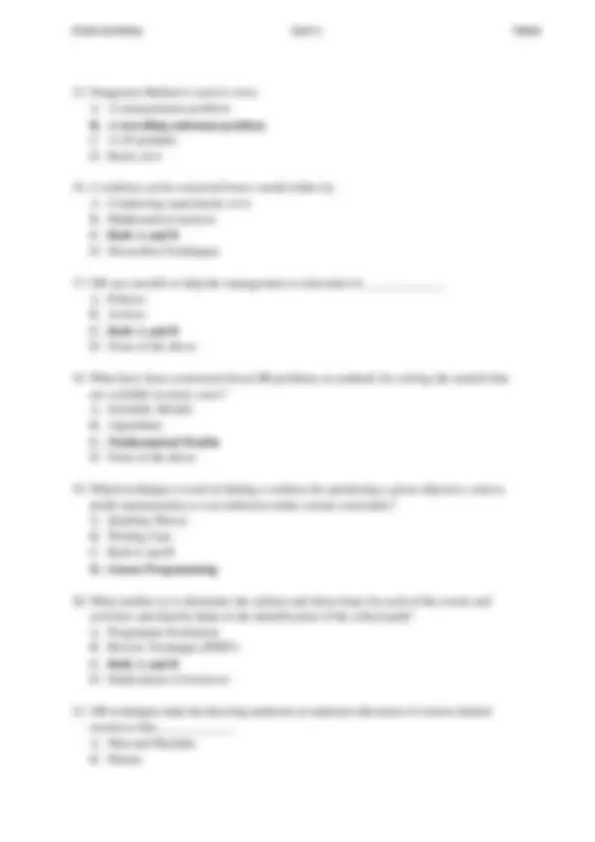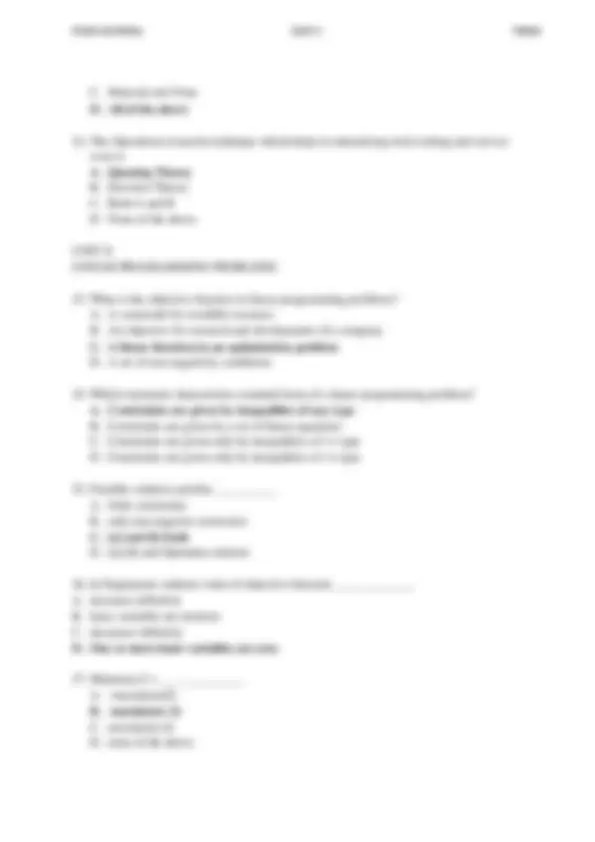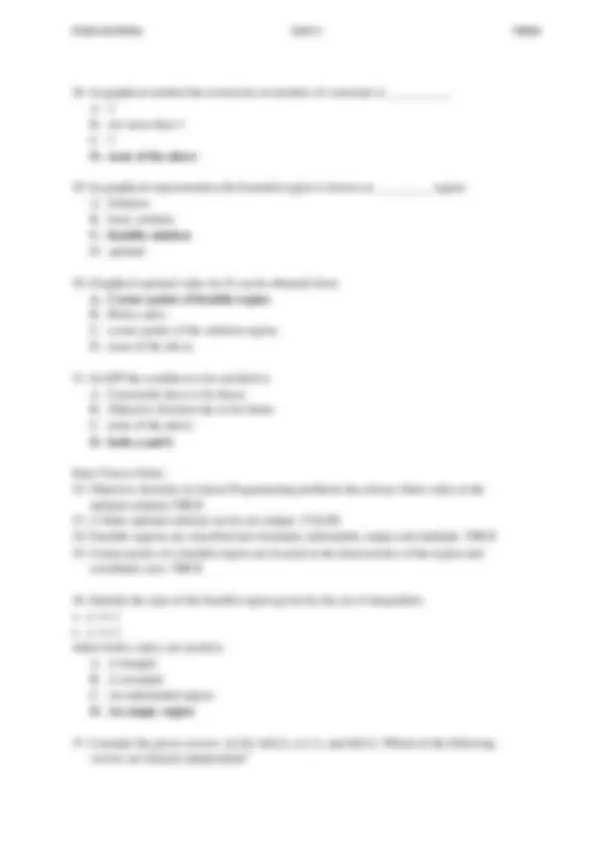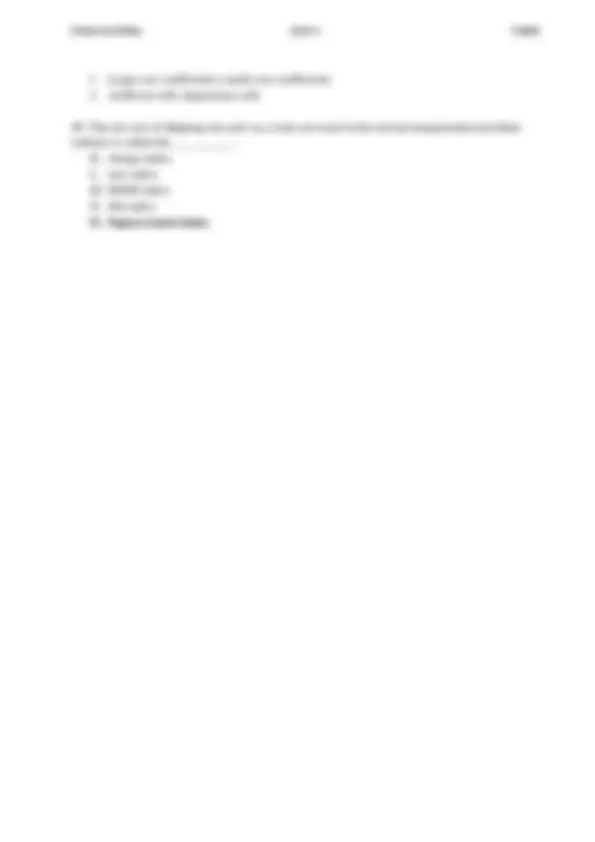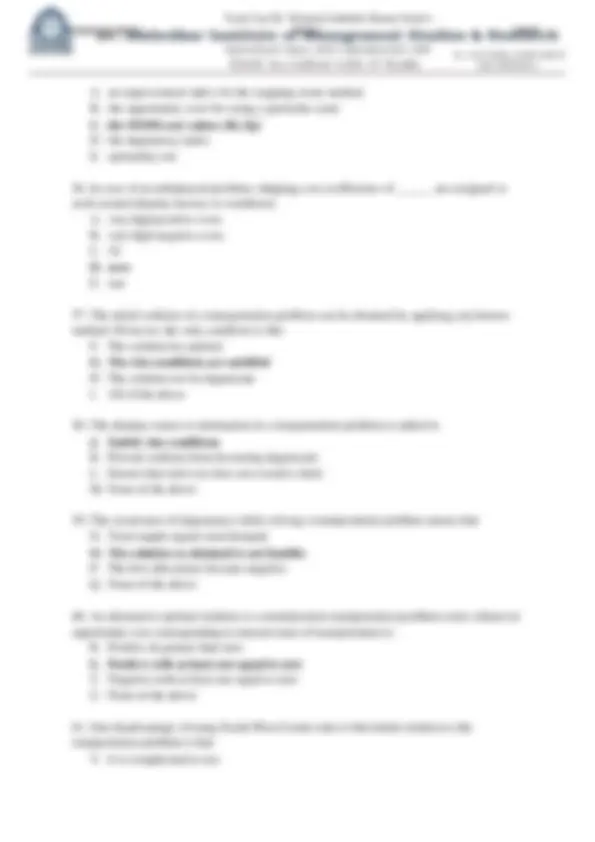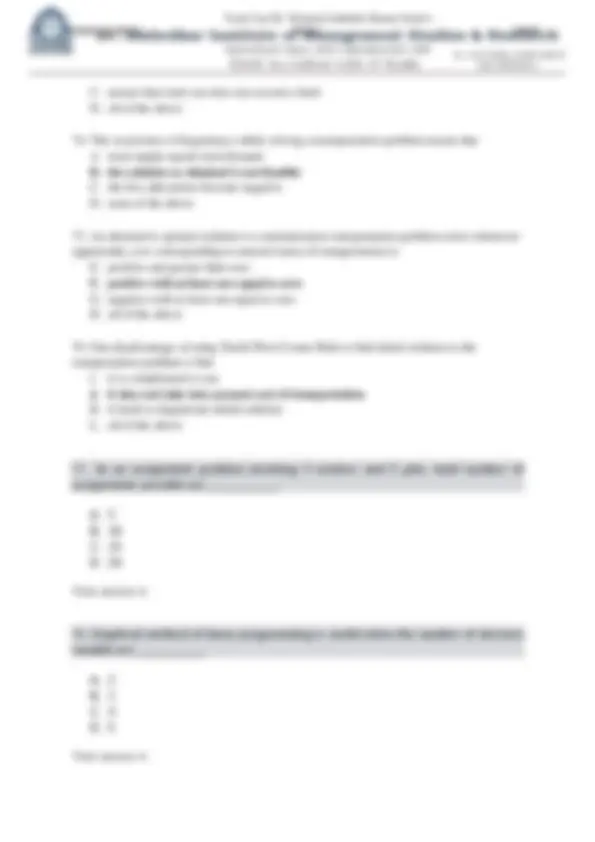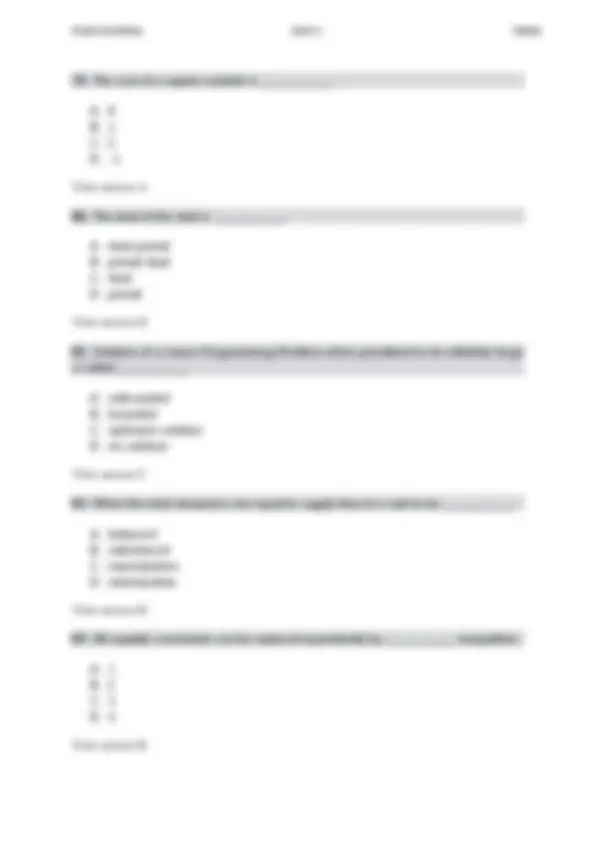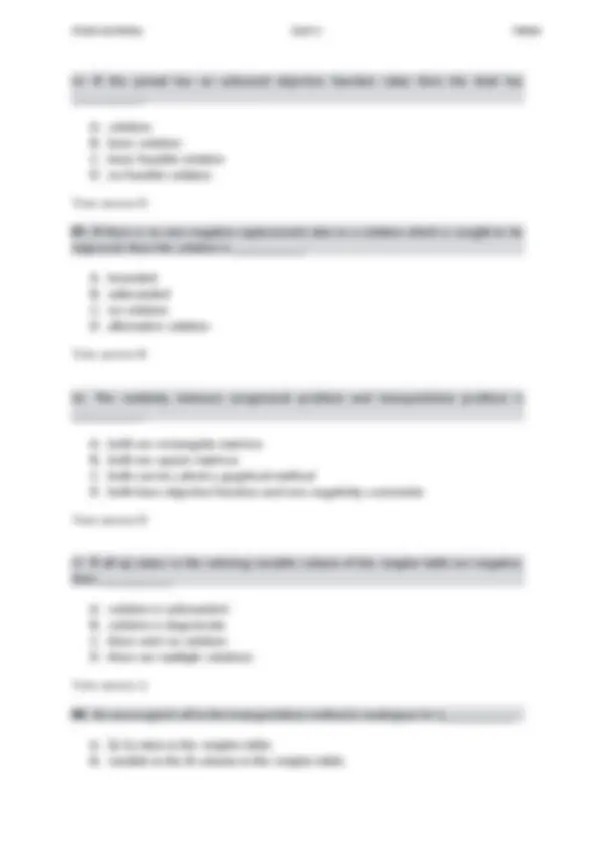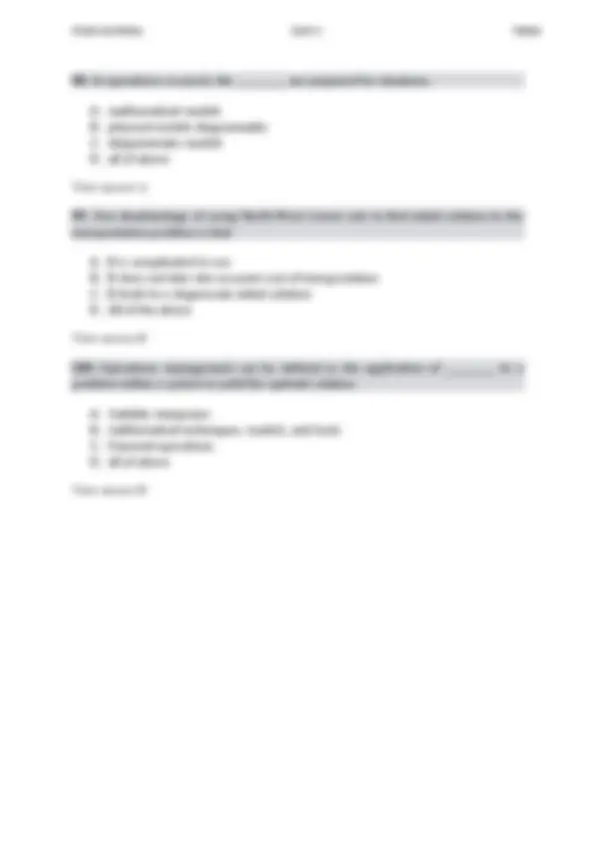Download OPERATIONS RESEARCH EXAMPLE EXAM QUESTIONS and more Exams Operational Research in PDF only on Docsity!
OPERATIONS RESEARCH
Multiple Choice Questions
- Operations research is the application of ____________methods to arrive at the optimal Solutions to the problems.
A. economical B. scientific C. a and b both D. artistic
- In operations research, the ------------------------------are prepared for situations. A. mathematical models B. physical models diagrammatic C. diagrammatic models
- Operations management can be defined as the application of ----------------------------------- -------to a problem within a system to yield the optimal solution. A. Suitable manpower B. mathematical techniques, models, and tools C. Financial operations
- Operations research is based upon collected information, knowledge and advanced study of various factors impacting a particular operation. This leads to more informed ----------- --------------------------. A. Management processes B. Decision making C. Procedures
- OR can evaluate only the effects of --------------------------------------------------. A. Personnel factors. B. Financial factors C. Numeric and quantifiable factors.
True-False
- By constructing models, the problems in libraries increase and cannot be solved. A. True B. False
- Operations Research started just before World War II in Britain with the establishment of teams of scientists to study the strategic and tactical problems involved in military operations. A. True
B. False
- OR can be applied only to those aspects of libraries where mathematical models can be prepared. A. True B. False
- The main limitation of operations research is that it often ignores the human element in the production process. A. True B. False
- Which of the following is not the phase of OR methodology? A. Formulating a problem B. Constructing a model C. Establishing controls D. Controlling the environment
- The objective function and constraints are functions of two types of variables, _______________ variables and ____________ variables. A. Positive and negative B. Controllable and uncontrollable C. Strong and weak D. None of the above
- Operations research was known as an ability to win a war without really going in to ____ A. Battle field B. Fighting C. The opponent D. Both A and B
- Who defined OR as scientific method of providing execuitive departments with a quantitative basis for decisions regarding the operations under their control? A. Morse and Kimball (1946) B. P.M.S. Blackett (1948) C. E.L. Arnoff and M.J. Netzorg D. None of the above
- OR has a characteristics that it is done by a team of A. Scientists B. Mathematicians C. Academics D. All of the above
C. Material and Time D. All of the above
- The Operations research technique which helps in minimizing total waiting and service costs is A. Queuing Theory B. Decision Theory C. Both A and B D. None of the above
UNIT II
LINEAR PROGRAMMING PROBLEMS
- What is the objective function in linear programming problems? A. A constraint for available resource B. An objective for research and development of a company C. A linear function in an optimization problem D. A set of non-negativity conditions
- Which statement characterizes standard form of a linear programming problem? A. Constraints are given by inequalities of any type B. Constraints are given by a set of linear equations C. Constraints are given only by inequalities of >= type D. Constraints are given only by inequalities of <= type
- Feasible solution satisfies __________ A. Only constraints B. only non-negative restriction C. [a] and [b] both D. [a],[b] and Optimum solution
- In Degenerate solution value of objective function _____________. A. increases infinitely B. basic variables are nonzero C. decreases infinitely D. One or more basic variables are zero
- Minimize Z = ______________ A. – maximize(Z) B. -maximize(-Z) C. maximize(-Z) D. none of the above
- In graphical method the restriction on number of constraint is __________. A. 2 B. not more than 3 C. 3 D. none of the above
- In graphical representation the bounded region is known as _________ region. A. Solution B. basic solution C. feasible solution D. optimal
- Graphical optimal value for Z can be obtained from A. Corner points of feasible region B. Both a and c C. corner points of the solution region D. none of the above
- In LPP the condition to be satisfied is A. Constraints have to be linear B. Objective function has to be linear C. none of the above D. both a and b
State True or False:
- Objective function in Linear Programming problems has always finite value at the optimal solution-TRUE
- A finite optimal solution can be not unique- FALSE
- Feasible regions are classified into bounded, unbounded, empty and multiple: TRUE
- Corner points of a feasible region are located at the intersections of the region and coordinate axes: TRUE
- Identify the type of the feasible region given by the set of inequalities x - y <= 1 x - y >= 2 where both x and y are positive. A. A triangle B. A rectangle C. An unbounded region D. An empty region
- Consider the given vectors: a(2,0), b(0,2), c(1,1), and d(0,3). Which of the following vectors are linearly independent?
- The purpose of a dummy source or dummy destination in a transportation problem is to F. prevent the solution from becoming degenerate. G. obtain a balance between total supply and total demand. H. make certain that the total cost does not exceed some specified figure. I. provide a means of representing a dummy problem.
- Which of the following is NOT needed to use the transportation model?
A. the cost of shipping one unit from each origin to each destination B. the destination points and the demand per period at each C. the origin points and the capacity or supply per period at each D. degeneracy
- Which of the following is a method for improving an initial solution in a transportation problem? J. northwest-corner K. intuitive lowest-cost L. southeast-corner rule M. stepping-stone
- The transportation method assumes that
N. there are no economies of scale if large quantities are shipped from one source to one destination.
B. the number of occupied squares in any solution must be equal to the number of rows in the table plus the number of columns in the table plus 1. C. there is only one optimal solution for each problem. D. the number of dummy sources equals the number of dummy destinations.
- In a transportation problem, we must make the number of __________ and __________ equal. A. destinations; sources B. units supplied; units demanded C. columns; rows D. positive cost coefficients; negative cost coefficients E. warehouses; suppliers
- __________ or __________ are used to "balance" an assignment or transportation problem.
F. Destinations; sources G. Units supplied; units demanded H. Dummy rows; dummy columns
I. Large cost coefficients; small cost coefficients J. Artificial cells; degenerate cells
- The net cost of shipping one unit on a route not used in the current transportation problem solution is called the __________. K. change index L. new index M. MODI index N. idle index O. Improvement index
A. an improvement index for the stepping-stone method B. the opportunity costs for using a particular route C. the MODI cost values (Ri, Kj) D. the degeneracy index E. optimality test
- In case of an unbalanced problem, shipping cost coefficients of ______ are assigned to each created dummy factory or warehouse. A. very high positive costs B. very high negative costs C. 10 D. zero E. one
- The initial solution of a transportation problem can be obtained by applying any known method. However, the only condition is that F. The solution be optimal G. The rim conditions are satisfied H. The solution not be degenerate I. All of the above
- The dummy source or destination in a transportation problem is added to
J. Satisfy rim conditions K. Prevent solution from becoming degenerate L. Ensure that total cost does not exceed a limit M. None of the above
- The occurrence of degeneracy while solving a transportation problem means that N. Total supply equals total demand O. The solution so obtained is not feasible P. The few allocations become negative Q. None of the above
- An alternative optimal solution to a minimization transportation problem exists whenever opportunity cost corresponding to unused route of transportation is: R. Positive & greater than zero S. Positive with at least one equal to zero T. Negative with at least one equal to zero U. None of the above
- One disadvantage of using North-West Corner rule to find initial solution to the transportation problem is that
V. It is complicated to use
B. It does not take into account cost of transportation C. It leads to a degenerate initial solution D. All of the above
- The solution to a transportation problem with ‘m’ rows (supplies) & ‘n’ columns (destination) is feasible if number of positive allocations are A. m+n B. m*n C. m+n- D. m+n+
- If an opportunity cost value is used for an unused cell to test optimality, it should be E. Equal to zero F. Most negative number G. Most positive number H. Any value
- During an iteration while moving from one solution to the next, degeneracy may occur when B. The closed path indicates a diagonal move C. Two or more occupied cells are on the closed path but neither of them represents a corner of the path. D. Two or more occupied cells on the closed path with minus sign are tied for lowest circled value E. Either of the above
- The large negative opportunity cost value in an unused cell in a transportation table is chosen to improve the current solution because
A. It represents per unit cost reduction B. It represents per unit cost improvement C. It ensure no rim requirement violation D. None of the above
- The smallest quantity is chosen at the corners of the closed path with negative sign to be assigned at unused cell because F. It improve the total cost G. It does not disturb rim conditions H. It ensure feasible solution I. All of the above
- When total supply is equal to total demand in a transportation problem, the problem is said to be A. Balanced
C. ensure that total cost does not exceed a limit D. all of the above
- The occurrence of degeneracy while solving a transportation problem means that A. total supply equals total demand B. the solution so obtained is not feasible C. the few allocations become negative D. none of the above
- An alternative optimal solution to a minimization transportation problem exists whenever opportunity cost corresponding to unused routes of transportation is: E. positive and greater than zero F. positive with at least one equal to zero G. negative with at least one equal to zero H. all of the above
- One disadvantage of using North-West Corner Rule to find initial solution to the transportation problem is that I. it is complicated to use J. it does not take into account cost of transportation K. it leads to degenerate initial solution L. all of the above
- In an assignment problem involving 5 workers and 5 jobs, total number of assignments possible are ______________.
A. 5 B. 10 C. 15 D. 20
View answer A
- Graphical method of linear programming is useful when the number of decision variable are ______________
A. 2 B. 3 C. 4 D. 5
View answer A
79. The cost of a surplus variable is ______________.
A. 0 B. 1 C. 2 D. - 1
View answer A
80. The dual of the dual is ______________.
A. dual-primal B. primal-dual C. dual D. primal
View answer D
81. Solution of a Linear Programming Problem when permitted to be infinitely large is called ______________.
A. unbounded B. bounded C. optimum solution D. no solution
View answer C
82. When the total demand is not equal to supply then it is said to be ______________.
A. balanced B. unbalanced C. maximization D. minimization
View answer B
83. All equality constraints can be replaced equivalently by ______________ inequalities
A. 1 B. 2 C. 3 D. 4
View answer B
C. variable not in the B-column in the simplex table. D. value in the XB column in the simplex table.
View answer B
- The area bounded by all the given constraints is called ______________.
A. feasible region B. basic solution C. non feasible region D. optimum basic feasible solution
View answer A
- An activity is critical if its ______________ float is zero
A. total B. free C. independent D. interference
View answer A
- __________ occurs when the number of occupied squares is less than the number of rows plus
A. Degeneracy B. Infeasibility C. Unboundedness D. Unbalance
View answer A
- Hungarian Method is used to solve
A. A transportation problem B. A travelling salesman problem C. A LP problem D. Both a & b
View answer B
- In assignment problem of maximization, the objective is to maximise
A. Profit B. optimization C. cost D. Loss
View answer A
- In Degenerate solution value of objective function __________.
A. increases infinitely B. basic variables are nonzero C. decreases infinitely D. One or more basic variables are zero
View answer D
- In graphical method the restriction on number of constraint is __________.
A. 2 B. not more than 3 C. 3 D. none of the above
View answer D
96. In graphical representation the bounded region is known as __________ region.
A. Solution B. basic solution C. feasible solution D. optimal
View answer C
- In LPP the condition to be satisfied is
A. Constraints have to be linear B. Objective function has to be linear C. none of the above D. both a and b
View answer D

